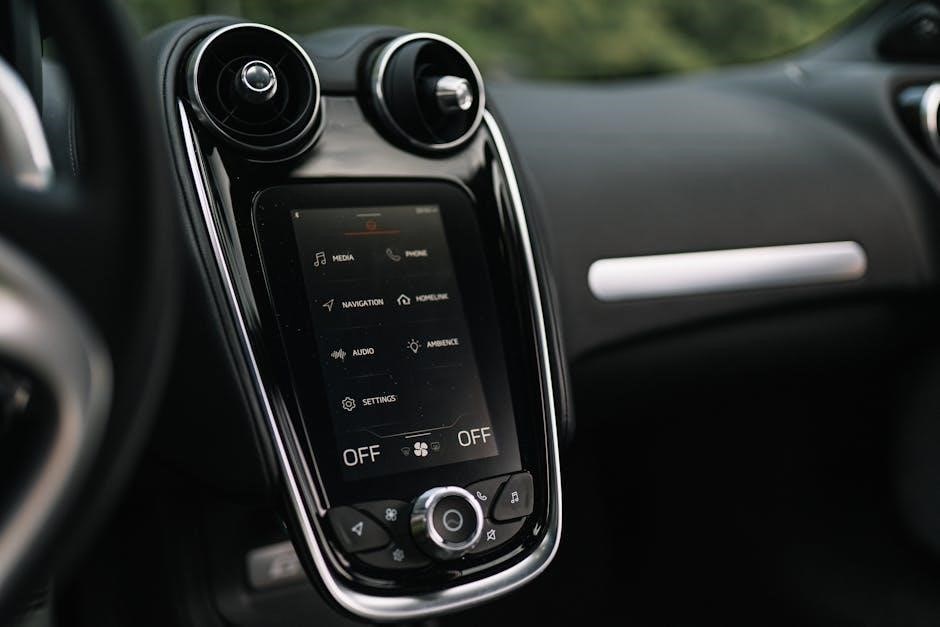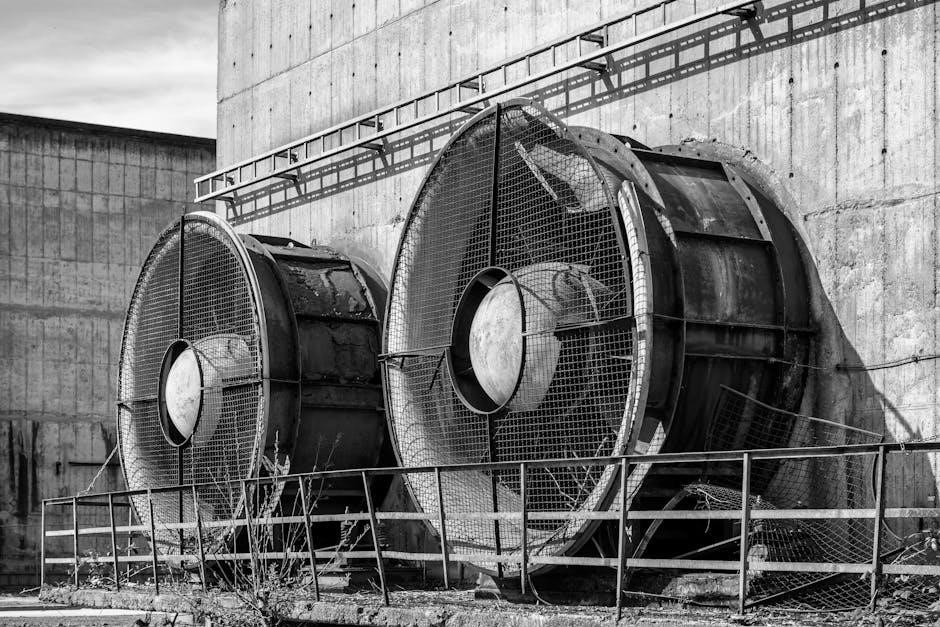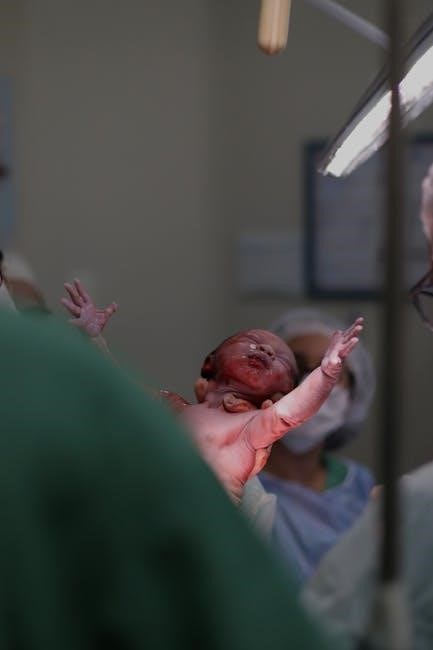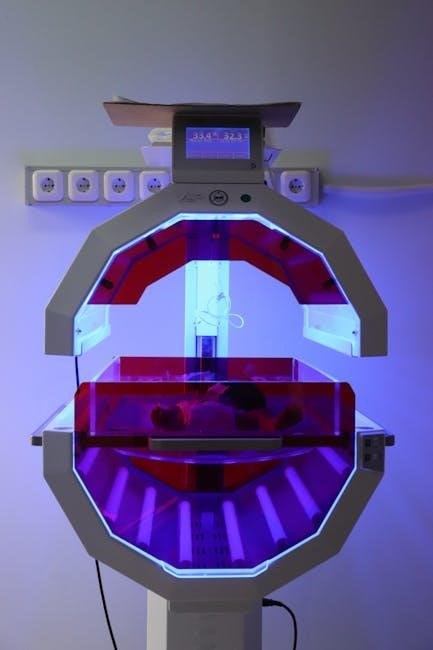Neonatal ventilator settings are crucial for supporting preterm and critically ill infants․ CPAP and pressure ventilation are commonly used‚ but settings vary by situation․ Proper training is essential for optimal outcomes․
1․1․ Importance of Ventilator Settings in Neonatal Care
Accurate neonatal ventilator settings are vital for ensuring proper respiratory support‚ preventing complications‚ and promoting healthy lung development in preterm or critically ill infants․ Proper settings help maintain adequate oxygenation and ventilation while minimizing the risk of lung injury․ Healthcare providers must carefully tailor settings to individual patient needs‚ as standardized protocols may not apply universally․ This customization is critical for optimizing outcomes and reducing long-term respiratory morbidity in neonates․
1․2․ Overview of Ventilator Types for Neonates
Neonatal ventilators are categorized into invasive and non-invasive types․ Invasive ventilators require intubation‚ while non-invasive options like CPAP use nasal interfaces․ Pressure ventilators deliver air at set pressures‚ and volume ventilators target specific tidal volumes․ Hybrid modes combine pressure and volume strategies․ The choice depends on the neonate’s condition‚ lung maturity‚ and clinical needs․ Proper selection ensures effective respiratory support while minimizing complications․

Types of Neonatal Ventilators
Neonatal ventilators include invasive‚ non-invasive‚ and hybrid systems․ Invasive ventilators use endotracheal tubes‚ while non-invasive options like CPAP support breathing without intubation‚ offering tailored solutions for neonatal care․
2․1․ Invasive Ventilators
Invasive ventilators are essential in neonatal intensive care units (NICUs) for babies with severe respiratory failure․ They require endotracheal intubation‚ providing precise control over breaths․ These ventilators are crucial for neonates unable to breathe independently‚ delivering set rates and pressures․ While they offer life-saving support‚ invasive ventilation carries risks like lung injury․ Trained healthcare professionals must carefully manage settings to balance support and minimize complications‚ ensuring optimal outcomes for critically ill infants․
2․2․ Non-Invasive Ventilators
Non-invasive ventilators‚ such as CPAP and biphasic positive airway pressure (BiPAP)‚ are widely used in neonatal care․ These methods deliver respiratory support without requiring intubation‚ reducing lung injury risks․ CPAP is particularly effective for preterm infants‚ improving lung expansion and gas exchange․ Non-invasive ventilation is often the first-line treatment for mild respiratory distress‚ promoting comfort and minimizing complications․ Regular clinical assessment is crucial to ensure optimal settings and patient response․
2․3․ Hybrid Ventilation Modes
Hybrid ventilation modes combine elements of invasive and non-invasive techniques‚ offering flexibility for neonates with varying respiratory needs․ These modes synchronize ventilation with the infant’s breaths‚ reducing work of breathing while maintaining airway pressure․ Hybrid systems are particularly beneficial for preterm infants‚ as they adapt to changing lung mechanics and minimize lung injury․ They are tailored to individual patient needs‚ enhancing comfort and improving clinical outcomes in critical care settings․

Modes of Ventilation for Neonates
Modes of ventilation for neonates include CPAP‚ SIMV‚ and pressure ventilation․ Each mode is tailored to the infant’s respiratory needs‚ ensuring effective gas exchange and minimizing lung injury․
3․1․ Continuous Positive Airway Pressure (CPAP)
CPAP delivers a constant pressure to maintain neonatal airway patency‚ reducing work of breathing․ Commonly used for preterm infants‚ it prevents alveolar collapse and supports spontaneous breathing․ Studies show adherence to CPAP varies‚ with average usage rates providing insight into effectiveness․ Proper nasal interface fitting is crucial to avoid trauma․ Pressure settings typically range from 4-6 cm H2O‚ tailored to individual needs․ Regular clinical monitoring ensures optimal respiratory support and minimizes complications․
3․2․ Synchronized Intermittent Mandatory Ventilation (SIMV)
SIMV delivers synchronized breaths with the neonate’s spontaneous efforts‚ promoting respiratory muscle activity․ It is widely used in preterm infants to support breathing while minimizing lung injury․ Key settings include rate‚ peak inspiratory pressure (PIP)‚ positive end-expiratory pressure (PEEP)‚ and inspiratory time․ SIMV helps maintain lung volume and improves gas exchange‚ making it a versatile mode for neonatal care․ Regular adjustments based on clinical assessment and blood gas analysis are essential for optimal outcomes․
3․3․ High-Frequency Ventilation (HFV)
High-Frequency Ventilation (HFV) delivers very small tidal volumes at rapid rates‚ often between 3-15 Hz‚ to maintain lung recruitment while minimizing lung injury․ It is particularly useful for neonates with severe respiratory distress syndrome (RDS) or those unresponsive to conventional ventilation․ HFV reduces the risk of barotrauma and volutrauma‚ making it ideal for fragile preterm lungs․ It is often reserved for cases where traditional methods fail‚ requiring precise monitoring and expertise to optimize outcomes․

Initial Setup and Configuration
Initial setup involves clinical assessment of the neonate’s respiratory needs‚ selecting appropriate modes‚ and setting PIP and PEEP levels․ Trained staff ensure accurate configuration for optimal support․
4․1․ Determining Initial Ventilator Settings
Determining initial ventilator settings for neonates involves assessing birth weight‚ gestational age‚ and clinical condition․ CPAP is often started at 4-6 cm H₂O‚ while pressure ventilation may begin with PIP of 15-20 cm H₂O and PEEP of 4-6 cm H₂O․ Initial settings are guided by the infant’s response‚ including chest rise and blood gas results․ Skilled staff adjust parameters to ensure adequate ventilation while minimizing lung injury․
4․2․ Adjusting Settings Based on Patient Response
Adjusting ventilator settings requires continuous monitoring of the neonate’s respiratory mechanics and clinical response․ Key factors include respiratory rate‚ oxygen saturation‚ and blood gas results․ Clinicians must assess lung compliance and resistance‚ ensuring tidal volumes remain appropriate․ Fine-tuning PIP‚ PEEP‚ and inspiratory time helps optimize ventilation․ Regular reassessment ensures the neonate’s evolving needs are met‚ minimizing complications like VALI․ Documentation and collaboration with the healthcare team are essential for tailored adjustments․

Monitoring and Assessment
Monitoring and assessment involve regular blood gas analysis to evaluate ventilation efficacy․ Clinical signs‚ such as respiratory rate and oxygen saturation‚ are continuously observed․ Respiratory mechanics are closely tracked․
5․1․ Clinical Assessment of Ventilated Neonates
Clinical assessment of ventilated neonates involves evaluating breathing patterns‚ chest movement‚ and oxygen saturation․ Nurses monitor for signs of distress‚ such as retractions or grunting‚ and ensure proper synchronization with the ventilator; Regular checks of breath sounds and chest rise help confirm effective ventilation․ Blood gas results guide adjustments‚ ensuring adequate oxygenation and ventilation․ Continuous monitoring is crucial to prevent complications and optimize respiratory support‚ tailoring settings to the infant’s evolving needs․
5․2․ Role of Blood Gas Analysis
Blood gas analysis is critical for assessing oxygenation and ventilation in neonates․ It measures pH‚ PaCO2‚ and PaO2 levels‚ guiding adjustments to ventilator settings․ Regular analysis helps ensure optimal gas exchange‚ preventing hypo- or hypercapnia․ By monitoring these parameters‚ clinicians can fine-tune respiratory support‚ reducing the risk of complications like chronic lung disease․ Accurate interpretation of blood gas results is essential for improving outcomes in ventilated neonates․
5․3․ Monitoring Respiratory Mechanics
Monitoring respiratory mechanics in neonates on ventilation involves assessing tidal volumes‚ respiratory rate‚ and airway pressures․ Parameters like compliance and resistance help evaluate lung function․ Real-time data from ventilators guides adjustments to optimize breathing patterns and minimize injury․ Continuous observation ensures ventilatory support aligns with the infant’s changing needs‚ promoting lung protection and effective gas exchange․ Accurate interpretation of these metrics is vital for improving outcomes in critically ill neonates․

Pressure vs․ Volume Ventilation
Pressure ventilation maintains specific airway pressures‚ while volume ventilation targets precise tidal volumes․ Both modes aim to optimize neonatal respiratory support‚ but volume ventilation is less frequently used․
6․1․ Pressure-Limited Ventilation
Pressure-limited ventilation delivers breaths with a set maximum pressure‚ ensuring lung protection․ The ventilator automatically calculates breaths per minute and inspiratory-to-expiratory ratio․ It monitors peak inspiratory pressure (PIP) and positive end-expiratory pressure (PEEP) to maintain mean airway pressure (MAP)․ This mode is crucial for preventing lung injury in neonates‚ as it caps peak pressure․ It’s widely used for its adaptability to varying respiratory support needs while ensuring safe pressure levels․
6․2․ Volume-Targeted Ventilation
Volume-targeted ventilation delivers a set tidal volume‚ reducing lung injury risk․ It’s less common in neonates due to challenges in achieving precise volumes for small patients․ Modern systems adapt to respiratory mechanics‚ ensuring consistent delivery․ Monitoring parameters like PIP and PEEP is critical․ This mode is beneficial for preterm infants‚ as it minimizes overdistension and promotes synchronized breathing‚ improving comfort and effectiveness․
6․3․ Comparison of Pressure and Volume Modes
Pressure mode ventilation offers flexibility‚ adapting to a neonate’s breathing efforts‚ while volume mode ensures consistent tidal volumes․ Pressure modes are easier to wean but may vary with lung compliance․ Volume modes provide precise delivery but are less suited for preterm infants due to tidal volume limitations․ Clinical judgment guides the choice‚ balancing adaptability and precision for optimal neonatal care․

Complications and Challenges
Neonatal ventilation can lead to complications such as ventilator-associated lung injury (VALI) and chronic lung disease (CLD)․ Additionally‚ extrapolmonary effects like neurological issues may arise‚ necessitating careful monitoring and adjustment of settings to minimize harm and optimize outcomes for critically ill infants․
7․1․ Ventilator-Associated Lung Injury (VALI)
VALI is a significant complication in neonatal ventilation‚ caused by mechanical stress from ventilator settings․ Preterm infants are highly vulnerable due to underdeveloped lungs․ Elevated pressures and volumes can lead to inflammation and tissue damage․ Strategic use of gentle ventilation techniques and careful monitoring are essential to minimize risk․ Early detection and adjustment of settings are critical to prevent long-term respiratory complications in neonates․
7․2․ Chronic Lung Disease (CLD) in Neonates
Chronic Lung Disease (CLD) is a common complication in preterm neonates‚ often linked to prolonged mechanical ventilation․ Improper ventilator settings can cause lung injury‚ increasing CLD risk․ Invasive ventilation may exacerbate inflammation‚ while non-invasive methods like CPAP reduce this risk․ Long-term respiratory and developmental challenges highlight the need for careful management and monitoring to minimize CLD incidence in vulnerable patients․
7․3․ Extrapolmonary Complications
Extrapolmonary complications in neonatal ventilation include cardiovascular instability‚ infections‚ and nutritional challenges․ Prolonged ventilation can affect blood pressure and cardiac workload․ Infections may arise from invasive devices‚ while nutritional deficiencies can impair recovery․ Monitoring systemic effects and optimizing ventilator settings are critical to minimize these risks and ensure comprehensive care for vulnerable neonates․
Weaning from Ventilation
Weaning from ventilation is a critical process in neonatal care‚ requiring careful assessment of readiness․ Strategies include gradual reduction of support and close monitoring․ Post-extubation care ensures a smooth transition to independent breathing‚ minimizing complications and promoting long-term respiratory health․
8․1․ Criteria for Weaning Readiness
Assessing readiness for weaning involves evaluating the neonate’s respiratory stability and clinical condition․ Key criteria include a stable respiratory rate‚ adequate oxygenation (SpO₂ > 90%)‚ and acceptable blood gas levels (pCO₂ < 60 mmHg)․ The infant should also demonstrate consistent breathing efforts and maintain a positive end-expiratory pressure (PEEP) without distress․ Clinical judgment plays a critical role in determining when to initiate the weaning process safely and effectively․
8․2․ Strategies for Successful Weaning
Successful weaning involves gradual reduction of ventilator support while ensuring the neonate maintains stable respiratory function․ Clinicians monitor for signs of readiness‚ such as improved lung compliance and consistent breathing patterns․ Synchronized ventilation modes help reduce work of breathing․ Transitioning to non-invasive methods like CPAP post-extubation supports a smooth recovery․ Tailoring strategies to individual needs ensures a safer and more effective weaning process․
8․3․ Post-Extubation Care
Post-extubation care for neonates involves close monitoring for respiratory distress or failure․ Supplemental oxygen or non-invasive ventilation may be needed․ Feeding abilities should be assessed‚ and measures to prevent complications like atelectasis are essential; A multidisciplinary team ensures comprehensive support‚ addressing both respiratory and nutritional needs to promote recovery and reduce long-term pulmonary issues․

Troubleshooting Common Issues
Addressing high airway pressures‚ managing ineffective breathing‚ and handling ventilator alarms are critical․ Regular monitoring and staff training ensure timely resolution of these common neonatal ventilation challenges․
9․1․ Managing Ineffective Breathing
Managing ineffective breathing in neonates requires careful assessment and adjustment of ventilator settings․ Strategies include optimizing PEEP levels‚ ensuring adequate inspiratory time‚ and synchronizing ventilation with the infant’s breath․ Monitoring through blood gas analysis and clinical signs helps identify ineffective breathing patterns․ Adjustments may involve transitioning between CPAP and pressure ventilation modes․ Trained staff are essential for continuous assessment and timely interventions to improve respiratory efficiency and prevent complications․
9․2․ Addressing High Airway Pressures
High airway pressures in neonatal ventilation can indicate resistance or obstruction․ Ensure proper endotracheal tube (ETT) placement and suctioning to clear secretions․ Adjust PEEP and PIP levels carefully to avoid lung injury․ Sedation may be necessary to synchronize the infant’s breaths with the ventilator․ Regularly monitor pressure readings and tidal volumes to maintain safe thresholds․ Elevated pressures warrant immediate intervention to prevent complications like ventilator-associated lung injury (VALI)․
9․3․ Handling Ventilator Alarms
Handling ventilator alarms requires prompt attention to ensure neonatal safety․ Common alarms include high airway pressure‚ low exhaled volume‚ or disconnections․ Always assess the infant’s condition first․ Check tubing for kinks or blockages and ensure proper endotracheal tube placement․ Reset alarms only after resolving the issue․ Document the event and notify the healthcare team․ Regular equipment checks and staff training reduce false alarms and improve response efficiency․

Case Studies and Clinical Examples
Real-life examples demonstrate the effectiveness of tailored ventilator strategies․ A preterm infant with RDS showed improved oxygenation using CPAP‚ while a neonate with congenital anomalies required pressure ventilation․
10․1․ Successful Ventilation in Preterm Infants
Successful ventilation in preterm infants requires careful adjustment of settings to support fragile lungs․ CPAP is often used initially‚ while pressure ventilators help maintain adequate gas exchange․ Adjusting PEEP and pressure amplitude ensures proper lung expansion without injury; Volume-targeted ventilation may be effective for preterm lungs․ Close monitoring of blood gases and clinical signs is essential to avoid complications like chronic lung disease and ensure optimal outcomes․
10․2․ Managing Neonates with Congenital Anomalies
Neonates with congenital anomalies require tailored ventilator strategies․ Conditions like tracheoesophageal fistula or diaphragmatic hernia demand precise pressure settings to avoid lung injury․ CPAP may suffice for mild cases‚ while pressure ventilation is often necessary for more severe anomalies․ Monitoring for complications like pneumothorax is critical․ A multidisciplinary approach ensures optimal outcomes‚ balancing ventilatory support with surgical intervention needs․

Future Directions in Neonatal Ventilation
Advances in AI-driven ventilators and personalized ventilation strategies are expected to enhance neonatal care․ Non-invasive methods like HFNC may become more prominent‚ reducing lung injury risks․
11․1․ Advances in Ventilator Technology
Recent advancements in neonatal ventilator technology include improved monitoring systems‚ adaptive ventilation modes‚ and smaller‚ more precise devices․ These innovations enable better synchronization with the infant’s breathing patterns‚ reducing lung injury risks․ Real-time data analysis and integration with artificial intelligence are enhancing ventilator performance․ New designs focus on minimizing invasiveness and optimizing gas exchange‚ leading to improved clinical outcomes for preterm and critically ill neonates․
11․2․ Role of Artificial Intelligence
Artificial intelligence (AI) is transforming neonatal ventilation by optimizing settings and improving patient outcomes․ AI algorithms analyze real-time data to predict optimal pressures and volumes‚ reducing complications․ Machine learning helps identify patterns in patient responses‚ enabling personalized ventilation strategies․ Integration with medical devices enhances monitoring and automates adjustments‚ minimizing human error․ AI also aids in training healthcare professionals‚ ensuring evidence-based practices․ Its potential to revolutionize neonatal care is significant‚ offering precise and data-driven solutions․
Proper neonatal ventilator settings improve respiratory outcomes‚ emphasizing the need for continuous education and tailored approaches to enhance neonatal care effectively․
12․1․ Key Takeaways
Neonatal ventilator settings require precise balancing to support preterm and critically ill infants․ CPAP and pressure ventilation are cornerstone therapies‚ but optimal settings vary by patient․ Proper training and clinical expertise are essential to minimize lung injury and improve outcomes․ Continuous monitoring and adjustments ensure effective respiratory support‚ while advances in technology and AI promise better patient care․
12․2․ Importance of Continuous Education
Continuous education is vital for healthcare professionals to stay updated on advancements in neonatal ventilation․ It ensures understanding of best practices‚ new technologies‚ and evolving clinical guidelines․ Regular training improves proficiency in managing complex cases‚ reducing complications and enhancing patient outcomes․ Education fosters a culture of excellence‚ enabling clinicians to adapt to emerging trends and provide evidence-based care․ Ongoing learning is essential for optimizing ventilator settings and improving neonatal respiratory support․
